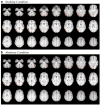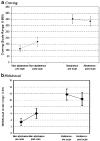Effects of Acute Nicotine Abstinence on Cue-elicited Ventral Striatum/Nucleus Accumbens Activation in Female Cigarette Smokers: A Functional Magnetic Resonance Imaging Study
- PMID: 18458752
- PMCID: PMC2367252
- DOI: 10.1007/s11682-007-9004-1
Effects of Acute Nicotine Abstinence on Cue-elicited Ventral Striatum/Nucleus Accumbens Activation in Female Cigarette Smokers: A Functional Magnetic Resonance Imaging Study
Abstract
To achieve greater understanding of the brain mechanisms underlying nicotine craving in female smokers, we examined the influence of nicotine non-abstinence vs. acute nicotine abstinence on cue-elicited activation of the ventral striatum. Eight female smokers underwent an event-related functional magnetic resonance imaging (fMRI) paradigm presenting randomized sequences of smoking-related and non-smoking related pictures. Participants were asked to indicate by a key press the gender of individuals in smoking-related and non-smoking related pictures (gender discrimination task), to maintain and evaluate attention to the pictures. There was a significant effect of smoking condition on reaction times (RT) for a gender discrimination task intended to assess and maintain attention to the photographs-suggesting a deprivation effect of acute nicotine abstinence and a statistical trend indicating greater RTs for smoking cues than neutral cues. BOLD contrast (smoking vs. non-smoking cues) was greater in the non-abstinent vs. acutely abstinent conditions in the ventral striatum including the nucleus accumbens (VS/NAc). Moreover, a significant positive correlation was observed between baseline cigarette craving prior to scanning and VS/NAc activation (r=0.84, p=0.009), but only in the non-abstinent condition. These results may either be explained by ceiling effects of nicotine withdrawal in the abstinent condition or, may indicate reduced relative activation (smoking vs. neutral contrast) in the VS/NAc in the abstinent vs. non-abstinent conditions in this group of female smokers.
Figures






Similar articles
-
24-h smoking abstinence potentiates fMRI-BOLD activation to smoking cues in cerebral cortex and dorsal striatum.Psychopharmacology (Berl). 2009 May;204(1):25-35. doi: 10.1007/s00213-008-1436-9. Epub 2008 Dec 24. Psychopharmacology (Berl). 2009. PMID: 19107465 Free PMC article.
-
Brain activation patterns associated with cue reactivity and craving in abstinent problem gamblers, heavy smokers and healthy controls: an fMRI study.Addict Biol. 2010 Oct;15(4):491-503. doi: 10.1111/j.1369-1600.2010.00242.x. Epub 2010 Sep 14. Addict Biol. 2010. PMID: 20840335 Free PMC article.
-
Assessment of the Choice Behavior Under Cued Conditions (CBUCC) paradigm as a measure of motivation to smoke under laboratory conditions.Addiction. 2020 Feb;115(2):302-312. doi: 10.1111/add.14771. Epub 2019 Aug 30. Addiction. 2020. PMID: 31390087
-
[Smoking reduction and temporary abstinence: new approaches for smoking cessation].J Mal Vasc. 2003 Dec;28(5):293-300. J Mal Vasc. 2003. PMID: 14978435 Review. French.
-
A review of the efficacy of smoking-cessation pharmacotherapies in nonwhite populations.Clin Ther. 2008 May;30(5):800-12. doi: 10.1016/j.clinthera.2008.05.010. Clin Ther. 2008. PMID: 18555928 Review.
Cited by
-
The effect of nicotine patches on craving in the brain: A functional MRI study on heavy smokers.Medicine (Baltimore). 2018 Sep;97(39):e12415. doi: 10.1097/MD.0000000000012415. Medicine (Baltimore). 2018. PMID: 30278517 Free PMC article. Clinical Trial.
-
Neural substrates of smoking cue reactivity: a meta-analysis of fMRI studies.Neuroimage. 2012 Mar;60(1):252-62. doi: 10.1016/j.neuroimage.2011.12.024. Epub 2011 Dec 21. Neuroimage. 2012. PMID: 22206965 Free PMC article.
-
Temporal Dynamics of Neural Response to Drug Cues in abstinent Methamphetamine Users.Basic Clin Neurosci. 2024 May-Jun;15(3):317-332. doi: 10.32598/bcn.2021.3126.1. Epub 2024 May 1. Basic Clin Neurosci. 2024. PMID: 39403362 Free PMC article.
-
Visual cortex activation to drug cues: a meta-analysis of functional neuroimaging papers in addiction and substance abuse literature.Drug Alcohol Depend. 2014 Oct 1;143:206-12. doi: 10.1016/j.drugalcdep.2014.07.028. Epub 2014 Aug 10. Drug Alcohol Depend. 2014. PMID: 25155889 Free PMC article.
-
Substrates of neuropsychological functioning in stimulant dependence: a review of functional neuroimaging research.Brain Behav. 2012 Jul;2(4):499-523. doi: 10.1002/brb3.65. Epub 2012 Jun 26. Brain Behav. 2012. PMID: 22950052 Free PMC article.
References
-
- Balfour DJ. Neuroplasticity within the mesoaccumbens dopamine system and its role in tobacco dependence. Current Drugs Targets CNS and Neurological Disorders. 2002;1(4):413–421. - PubMed
-
- Balfour DJ, Benwell ME, Birrell CE, Kelly RJ, Al-Aloul M. Sensitization of the mesoaccumbens dopamine response to nicotine. Pharmacology, Biochemistry and Behavior. 1998;59(4):1021–1030. - PubMed
-
- Beckmann CF, Jenkinson M, Smith SM. General multilevel linear modeling for group analysis in fmri. Neuroimage. 2003;20(2):1052–1063. - PubMed
-
- Bortolozzi A, Duffard R, de Duffard AM. Asymmetrical development of the monoamine systems in 2,4-dichlorophenoxy-acetic acid treated rats. Neurotoxicology. 2003;24(1):149–157. - PubMed
Grants and funding
LinkOut - more resources
Full Text Sources
